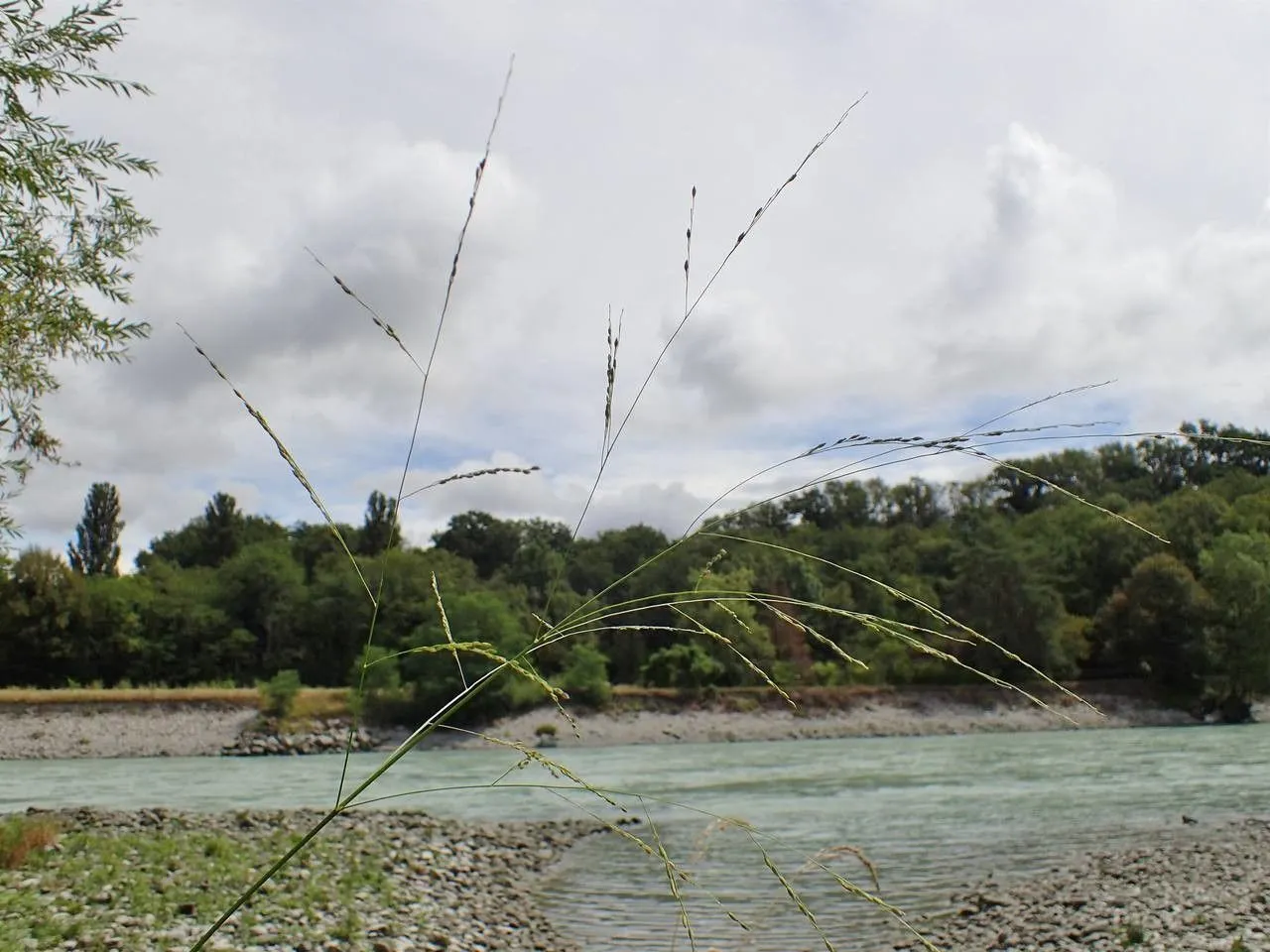
Author: Michx.
Bibliography: Fl. Bor.-Amer. 1: 48 (1803)
Year: 1803
Status: accepted
Rank: species
Genus: Panicum
Vegetable: False
Observations: America
Smooth witchgrass, scientifically named Panicum dichotomiflorum, is a notable member of the Poaceae family, a diverse group integral to various ecosystems. Originally documented in the early 19th century by Michx., this grass species holds its place in the botanical literature with its detailed description found in “Flora Boreali-Americana” published in 1803.
Primarily found across the American continent, smooth witchgrass is recognized for its resilience and adaptability to different environments. It typically thrives in disturbed soils, making it a common inhabitant of agricultural lands, roadsides, and other areas influenced by human activity.
Smooth witchgrass exhibits a distinctive morphology characterized by its smooth texture, which is reflected in its common name. The plant features a branching habit with thin, yet robust stems that contribute to its hardy nature. Its flowering pattern is notable for the dichotomous arrangement, where the flowers stem out in pairs along the inflorescence.
The role of smooth witchgrass extends beyond its ecological presence, contributing significantly to the habitat where it grows by providing ground cover that helps reduce soil erosion. Moreover, its presence in agricultural settings, though sometimes considered a weed, is an indication of its robust ability to flourish in various soil types and conditions.
For those studying grass species within the Poaceae family or exploring native American flora, Panicum dichotomiflorum serves as a fascinating subject. Its widespread presence and historical documentation offer valuable insights into the biodiversity and ecological dynamics of American plant life.
The work of Michx. in cataloging this species underscores the rich botanical heritage and the ongoing importance of documenting plant life for scientific and environmental understanding. Smooth witchgrass continues to be a species of interest both for its botanical traits and its role within its native habitats.
Eng: autumn millet, blue-grass, bluegrass, fall panic grass, fall panicum, fall panicgrass, smooth witchgrass, spreading panicgrass, cane grass
Deu: gabelblütige hirse, gabelästige hirse, gabelästige rispenhirse, reisfeld-hirse, spaetbluehende hirse, spätblühende rispenhirse
Dan: gaffel-hirse
Nld: kale gierst
Fra: millet, millet des rizières, panic, panic des rizières, panic d’automne, panic à inflorescence dichotome
Ita: panico delle risaie
Por: capim-arroxeado, capim-de-boi, capim-do-brejo, capim-miriam, grama-castelo, grama-de-castela
Ces: proso vidlicokvěté
Lav: zarot
Lit: šakotoji sora
Swe: hösthirs
Cym: miled yr hydref
En: Smooth witchgrass, Autumn millet, Fall panic grass, Fall panicum, Bluegrass, Fall panicgrass, Blue-grass, Cane grass, Spreading panicgrass
Ca: Mill
Cs: Proso vidlicokvěté
Da: Gaffel-hirse
Nl: Kale gierst
Fr: Millet, Millet des rizières, Panic, Panic des rizières, Panic d’automne, Panic à inflorescence dichotome, Millet dichotome, Panic dichotome, Panic à fleurs dichotomes
De: Gabelblütige Hirse, Gabelästige Hirse, Gabelästige Rispenhirse, Reisfeld-Hirse, Spaetbluehende Hirse, Spätblühende Rispenhirse, Spätblühende Hirse
It: Panico delle risaie
Lv: Zarot
Lt: Šakotoji sora
Pt: Capim-arroxeado, Capim-de-boi, Capim-do-brejo, Capim-miriam, Grama-castelo, Grama-de-castela
Es: Mijo, Pasto colchón
Sv: Hösthirs
Cy: Miled yr Hydref
Taken Sep 5, 2022 by cubs1225 (cc-by-sa)
Taken Aug 10, 2017 by Yoan MARTIN (cc-by-sa)
Taken Sep 5, 2022 by cubs1225 (cc-by-sa)
Taken Aug 9, 2020 by Frank Hübner (cc-by-sa)
Taken Jan 1, 1900 by EOL − USDA NRCS Wetland Science Institute. (public)
Taken Sep 29, 2014 by EOL − Michael Wunderli (cc-by)
Taken Aug 10, 2017 by Yoan MARTIN (cc-by-sa)
Taken Aug 10, 2017 by Yoan MARTIN (cc-by-sa)
Taken Aug 10, 2017 by Yoan MARTIN (cc-by-sa)
Taken Aug 10, 2017 by Yoan MARTIN (cc-by-sa)
Taken Sep 29, 2014 by EOL − Michael Wunderli (cc-by)
Taken Jan 1, 1900 by EOL − John Hilty (cc-by-nc)
Taken Aug 10, 2017 by Yoan MARTIN (cc-by-sa)
Taken Aug 10, 2017 by Yoan MARTIN (cc-by-sa)
Taken Sep 27, 2015 by Tela Botanica − Florent BECK (cc-by-sa)
Taken Aug 10, 2017 by Yoan MARTIN (cc-by-sa)
Taken Sep 29, 2020 by Aurélien Delatre (cc-by-sa)
Taken Aug 10, 2017 by Yoan MARTIN (cc-by-sa)
Taken Aug 10, 2017 by Yoan MARTIN (cc-by-sa)
Taken Sep 29, 2020 by Aurélien Delatre (cc-by-sa)
Taken May 2, 2019 by Clara SANS (cc-by-sa)
Taken May 23, 2019 by Paula Lagiewski (cc-by-sa)
Taken Jan 6, 2020 by Esther b Eloise b (cc-by-sa)
Taken Aug 5, 2008 by Tela Botanica − Mathieu MENAND (cc-by-sa)
Taken Aug 5, 2008 by Tela Botanica − Mathieu MENAND (cc-by-sa)
Taken Oct 15, 2018 by Photoflora – Benoit BOCK (©)
Taken Aug 15, 2015 by Photoflora – Benoit BOCK (©)
Taken Aug 15, 2006 by Photoflora – Benoit BOCK (©)
Taken Sep 27, 2015 by Tela Botanica − Florent BECK (cc-by-sa)
Taken Sep 27, 2015 by Tela Botanica − Florent BECK (cc-by-sa)
© copyright of the Board of Trustees of the Royal Botanic Gardens, Kew.
© copyright of the Board of Trustees of the Royal Botanic Gardens, Kew.
Growth form: Bunch
Growth habit: Graminoid
Growth rate: Rapid
Ph maximum: 7.0
Ph minimum: 4.8
Light: 9
Atmospheric humidity: 3
Soil nutriments: 7
Family: Myrtaceae Author: (F.Muell.) K.D.Hill & L.A.S.Johnson Bibliography: Telopea 6: 402 (1995) Year: 1995 Status:…
Family: Rubiaceae Author: Pierre ex A.Froehner Bibliography: Notizbl. Bot. Gart. Berlin-Dahlem 1: 237 (1897) Year:…
Family: Sapindaceae Author: Koidz. Bibliography: J. Coll. Sci. Imp. Univ. Tokyo 32(1): 38 (1911) Year:…
Family: Asteraceae Author: A.Gray Bibliography: Pacif. Railr. Rep.: 107 (1857) Year: 1857 Status: accepted Rank:…
Family: Fabaceae Author: Medik. Bibliography: Vorles. Churpfälz. Phys.-Ökon. Ges. 2: 398 (1787) Year: 1787 Status:…
Family: Aspleniaceae Author: (Cav.) Alston Bibliography: Bull. Misc. Inform. Kew 1932: 309 (1932) Year: 1932…